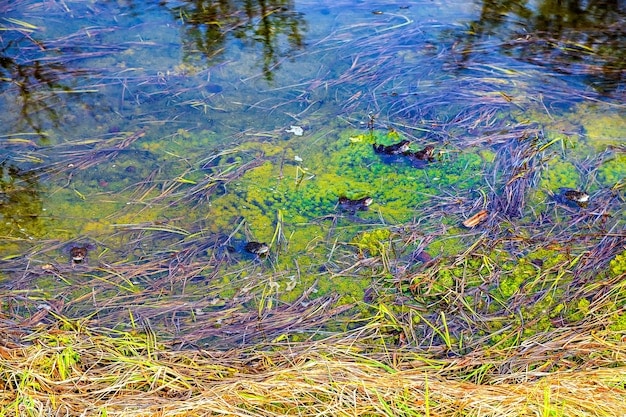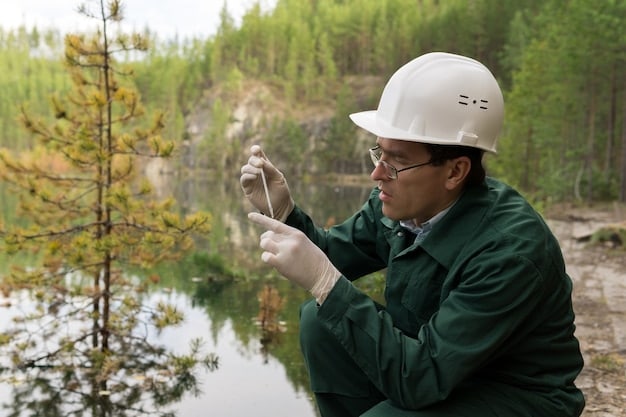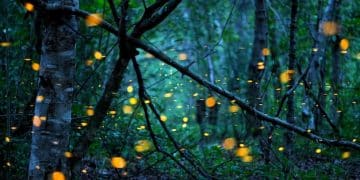Amphibian Decline: Latest Research on Vanishing Frogs & Salamanders in the US

The latest research on amphibian decline reveals a concerning trend of vanishing frog and salamander populations across the US, primarily due to habitat loss, pollution, climate change, and the spread of infectious diseases like chytridiomycosis, threatening biodiversity and ecosystem health.
Across the United States, a silent crisis is unfolding in our ponds, rivers, and forests. The latest research on amphibian decline paints a grim picture: frog and salamander populations are vanishing at an alarming rate. What’s causing this decline, and what can we do to stop it?
Understanding Amphibian Decline in the US
Amphibians, including frogs and salamanders, are vital components of many ecosystems. They serve as both predators and prey, playing a crucial role in maintaining ecological balance. However, their populations are facing unprecedented threats across the United States.
Scientists are working diligently to understand the complex factors contributing to amphibian decline. This involves studying disease patterns, habitat changes, and the impact of human activities on their survival.

The Ecological Importance of Amphibians
Amphibians are often considered indicator species, meaning their health reflects the overall health of the environment. Their permeable skin makes them particularly susceptible to pollutants and environmental changes.
What makes amphibians so crucial to our ecosystem?
- They control insect populations, preventing outbreaks that can damage crops and forests.
- They serve as a food source for larger animals, including birds, reptiles, and mammals.
- They play a role in nutrient cycling, contributing to the health of aquatic ecosystems.
Understanding the ecological importance of amphibians is the first step in addressing the crisis they face. Protecting their habitats and mitigating threats is essential for maintaining healthy ecosystems.
Amphibian decline is a complex issue with interconnected causes. By understanding these factors and recognizing the importance of amphibians, we can work towards effective conservation strategies.
Habitat Loss and Fragmentation
One of the primary drivers of amphibian decline is the loss and fragmentation of their habitats. As human populations grow and development expands, natural landscapes are converted into urban areas, agricultural lands, and industrial sites.
This habitat loss disrupts the life cycles of frogs and salamanders, limiting their ability to find food, shelter, and breeding sites.
The Impact of Urbanization
Urban development often leads to the destruction of wetlands, forests, and other habitats essential for amphibians. Roads and buildings create barriers that prevent amphibians from migrating and accessing different parts of their habitat.
How can we mitigate the impact of urbanization on amphibian populations?
Maintaining connectivity between habitats is crucial for allowing amphibians to move freely and maintain genetic diversity. This can be achieved through the creation of wildlife corridors and the protection of green spaces within urban areas.
- Conserving existing wetlands and forests within urban areas.
- Creating green infrastructure, such as rain gardens and green roofs, to provide habitat for amphibians.
- Implementing responsible land management practices that minimize the impact on amphibian habitats.
Habitat loss and fragmentation are significant threats to amphibian populations. By implementing conservation measures and promoting sustainable land management practices, we can help protect their habitats and ensure their survival.
Protecting and restoring amphibian habitats is paramount to ensuring the survival of these creatures.
The Role of Pollution
Pollution plays a significant role in the decline of amphibian populations. Amphibians are highly sensitive to environmental contaminants due to their permeable skin, which allows them to absorb water and nutrients directly from their surroundings.
Exposure to pollutants can lead to a range of health problems, including developmental abnormalities, immune system suppression, and increased susceptibility to disease.
Types of Pollution Affecting Amphibians
Several types of pollutants pose a threat to amphibian populations, including pesticides, herbicides, heavy metals, and industrial chemicals. These contaminants can enter aquatic ecosystems through runoff from agricultural fields, industrial discharges, and urban stormwater.
How does the presence of these pollutants affect the amphibians?
Pesticides and Herbicides
Pesticides and herbicides, commonly used in agriculture and landscaping, can have toxic effects on amphibians. These chemicals can disrupt their endocrine systems, leading to reproductive problems and developmental abnormalities.
Heavy Metals
Heavy metals, such as mercury and lead, can accumulate in amphibian tissues and cause neurological damage, impaired growth, and reduced survival rates. These contaminants can enter aquatic ecosystems through industrial emissions and mining activities.
Pollution is a significant driver of amphibian decline. By reducing pollution levels and implementing responsible waste management practices, we can improve the health of aquatic ecosystems and protect amphibian populations.
By reducing our impact on the environment we can start to heal the harm we have done.

Climate Change Impacts
Climate change is emerging as a significant threat to amphibian populations around the world, including the United States. Changes in temperature and precipitation patterns can alter amphibian habitats, disrupt their life cycles, and increase their susceptibility to disease.
Amphibians are particularly vulnerable to climate change due to their dependence on water for reproduction and their limited ability to regulate their body temperature.
Changes in Temperature and Precipitation
Rising temperatures can lead to the desiccation of wetlands and breeding ponds, reducing the availability of suitable habitat for amphibians. Changes in precipitation patterns can also disrupt their breeding cycles, leading to decreased reproductive success.
Global warming is having a negative affect on species all over the globe.
- Increased frequency and intensity of droughts, leading to the loss of breeding habitats.
- Changes in the timing of rainfall, disrupting amphibian breeding cycles.
- Increased frequency and intensity of extreme weather events, such as floods and hurricanes, which can destroy amphibian habitats.
Climate change is a growing threat to amphibian populations. By reducing greenhouse gas emissions and mitigating the impacts of climate change, we can help protect amphibian habitats and ensure their survival in a changing world.
Making gradual changes to your lifestyle, for a greener way of living, can drastically help our ecosystems.
The Spread of Infectious Diseases
Infectious diseases are a major cause of amphibian decline worldwide. One of the most devastating diseases affecting amphibian populations is chytridiomycosis, caused by the chytrid fungus *Batrachochytrium dendrobatidis* (Bd).
Chytridiomycosis has been linked to the extinction of several amphibian species and continues to threaten populations across the United States and around the globe.
Chytridiomycosis: A Global Threat
Chytridiomycosis is a fungal disease that infects the skin of amphibians, disrupting their ability to regulate water and electrolyte balance. Infected amphibians can die from dehydration or cardiac arrest.
Where does the disease come from?
- The movement of infected amphibians between regions.
- The introduction of Bd into new areas through human activities.
- The presence of reservoir hosts, such as bullfrogs, which can carry the fungus without showing symptoms.
Infectious diseases, such as chytridiomycosis, pose a significant threat to amphibian populations. By implementing biosecurity measures and managing disease outbreaks, we can help protect amphibians from these devastating infections.
Diseases can spread rampantly through certain species of amphibians, and can quickly lead to their demise.
Conservation Efforts and Solutions
Despite the challenges facing amphibian populations, there is hope for their future. Numerous conservation efforts are underway to protect amphibians and their habitats, both in the United States and around the world.
These efforts include habitat restoration, disease management, captive breeding programs, and public education initiatives.
Habitat Restoration and Protection
Protecting and restoring amphibian habitats is essential for their survival. This involves conserving wetlands, forests, and other natural areas, as well as creating corridors that connect fragmented habitats.
What can you do to help protect the habitats closest to you?
- Establishing protected areas and wildlife refuges.
- Implementing sustainable land management practices that minimize the impact on amphibian habitats.
- Restoring degraded habitats through wetland restoration projects and reforestation efforts.
Conservation efforts are crucial for protecting amphibian populations and their habitats. By supporting these initiatives and promoting sustainable practices, we can help ensure the survival of these important creatures for generations to come.
With the right support network and the appropriate funding, amphibian populations can thrive once more.
| Key Point | Brief Description |
|---|---|
| 🏠 Habitat Loss | Destruction of natural habitats due to urbanization and agriculture. |
| ☠️ Pollution | Exposure to pesticides, heavy metals, and industrial chemicals. |
| 🌡️ Climate Change | Changes in temperature and precipitation patterns affecting habitats. |
| 🍄 Infectious Diseases | Spread of diseases like chytridiomycosis causing mass mortality. |
Frequently Asked Questions
▼
Amphibian decline is attributed to multiple factors including habitat loss, pollution, climate change, and infectious diseases. These combined stresses make amphibians particularly vulnerable.
▼
Chytridiomycosis is a fungal disease caused by the chytrid fungus (Bd) that infects the skin of amphibians, disrupting their ability to regulate water and electrolyte balance, often leading to death.
▼
Climate change alters amphibian habitats by changing temperature and precipitation patterns. This leads to the desiccation of wetlands, disrupts breeding cycles, and increases susceptibility to disease.
▼
Protecting amphibian habitats involves conserving wetlands and forests, creating wildlife corridors, and implementing sustainable land management practices that minimize the impact on these environments.
▼
Individuals can reduce pesticide use, support conservation organizations, avoid introducing non-native species into local ecosystems, and advocate for policies that protect wetlands and natural habitats.
Conclusion
The decline of amphibian populations in the United States is a serious ecological issue with far-reaching consequences. By understanding the multifaceted factors driving this decline and supporting conservation efforts, we can work together to protect these vital creatures and preserve the health of our ecosystems for future generations.





